Today’s Current Affairs: 20th June 2024 for UPSC IAS exams, State PSC exams, SSC CGL, State SSC, RRB, Railways, Banking Exam & IBPS, etc
Table of Contents
My Mercury : Documentary

The documentary “My Mercury” premiered at the 18th Mumbai International Film Festival (MIFF) for Documentary, Short Fiction, and Animation Films.
- The film explores the life of her brother, Yves Chesselet, a conservationist on Mercury Island off the coast of Namibia.
- The 104-minute documentary portrays Yves’ efforts to reclaim the island for endangered seabirds and seals, emphasizing the psychological challenges and deep bond between man and nature.
- Mercury Island is a small rocky island off The Diamond Coast, Namibia.
- Despite its small size, it is recognised by BirdLife International and other global conservation groups as an Important Bird Area (IBA) for its significant coastal seabird breeding.
HelpAge India Report:

HelpAge India’s report, “Ageing in India: Exploring Preparedness & Response to Care Challenges,” was recently released to commemorate ‘World Elder Abuse Awareness Day (WEAAD)’ on 15th June, 2024.
Key findings from the report include:
- Illiteracy and Income Sources Around 40%, who are illiterate reported not having access to any income sources, compared to 29% of literate respondents.
- Elder Abuse 7% faced elder abuse, with no variation across gender and age groups.
- Work Participation Only 15% of elderly persons reported currently working (24% males, 7% females).
- Social Security Only 29% reported having access to social security schemes
- Income Levels 32% had an annual income below Rs 50,000, and 1 in 3 elders reported no income in the past year.
- WEAAD was officially recognised by the United Nations General Assembly in its resolution 66/127 in 2011.
- Theme for 2024 is Spotlight on Older Persons in Emergencies.
- The aim is to raise awareness about the plight of elderly people who are abused and harmed.
Mifepristone:
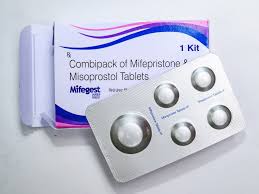
The US Supreme Court rejected a petition from anti-abortion groups aiming to overturn the Food and Drug Administration’s (FDA) approval of an abortion pill “mifepristone”.
- Mifepristone is a medication used to end pregnancies by blocking the hormone progesterone and dilating the cervix.
- It is typically taken with misoprostol to induce contractions and end a pregnancy within 10 weeks. The success rate of this pill is 97.4%.
- On the other hand, ‘miscarriage’ is used when a fetus is expelled from the fourth to the seventh month of gestation, before it is viable.
- Section 312 of IPC criminalises causing a miscarriage, except to save the woman’s life. The woman who attempts to cause her own miscarriage also falls under this section.
- The Medical Termination of Pregnancy (MTP) Act, of 1971 was introduced to allow safer abortions.
- As per the amended act (2021) for pregnancy up to 20 weeks, the opinion of one doctor is required and for pregnancy of 20 to 24 weeks, the opinion of two doctors is required.
- Unmarried women seeking abortions after 20 weeks face challenges due to a lack of specific provisions.
- The term ‘abortion’ is used only when an ovum is expelled within the first three months of pregnancy.
5G Intelligent Village And ‘Quantum Encryption Algorithm:

The Department of Telecommunications (DoT) has announced two significant calls for proposals to stimulate innovation and technological advancement in the telecommunications sector.
- These initiatives aim to promote indigenous R&D, IP creation, and inclusive digital growth across India under the Telecom Technology Development Fund (TTDF) scheme.
- Initiative 5G Intelligent Village Initiative Quantum Encryption Algorithm (QEA)
- Objective is to harness 5G technology to transform rural life, driving digital inclusion and economic growth. To develop an India-specific quantum encryption algorithm for securing digital communication channels.
- Scope Focuses on agriculture, education, healthcare, governance, and sustainability in selected villages across India. Not
- Goals Enable effective utilization of 5G’s URLLC and mMTC, establish 5G connectivity in uncovered areas, and unite various stakeholders for R&D in 5G technology. Not Applicable
- Features Not Applicable Unparalleled security, advanced encryption capabilities, and ultrafast, efficient encryption.
World Crocodile Day 2024:
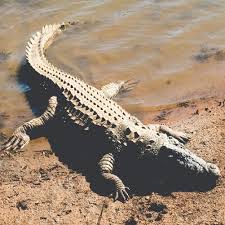
World Crocodile Day is celebrated on 17th June. The day is a global awareness campaign to highlight the plight of endangered crocodiles and alligators around the world.
- The Crocodile Conservation Project was initiated by the United Nations and the Government of India, shortly after the passage of the Wild Life (Protection) Act, 1972.
- The primary objectives were to protect natural habitats, boost crocodile populations through captive breeding, and address the low survival rates of hatchlings in the wild.
- The project set up breeding and rearing centers at 34 sites in India, including Bhitarkanika, to protect and revive the country’s endangered crocodilian population, particularly focusing on estuarine or saltwater crocodiles (Crocodylus porosus).
- The saltwater crocodile population in Bhitarkanika has significantly increased from 95 individuals in 1975 to 1,811 as of the latest reptile census report (2023).
- The saltwater crocodile is now found in three primary locations in India: Bhitarkanika, the Sundarbans, and the Andaman and Nicobar Islands.
Ghaggar River:
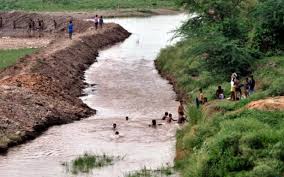
The Punjab Chief Minister recently visited flood-prone areas along the Ghaggar River to take stock of the preparations for dealing with floods at the ground level ahead of the monsoon.
- Ghaggar River is a seasonal river that flows only during the monsoon season.
- It rises from the Shivalik Range in northwestern Himachal Pradesh.
- The river then flows about 200 miles (320 km) southwest through Haryana state to meet the River Saraswati.
- It eventually dries up in the Thar Desert in Rajasthan.
- This seasonal river feeds two irrigation canals that extend into Rajasthan.
- The Hakra, which flows in Pakistan, is the continuation of the Ghaggar River in India, and they are together called the Ghaggar – Hakra River.
- It is believed that the rivers Sutlej and Yamuna once flowed into the Ghaggar-Hakra river bed.
- The main tributaries of the Ghaggar are the Kaushalya River, Markanda, Sarsuti, Tangri, and Chautang.
New Nalanda University Campus:
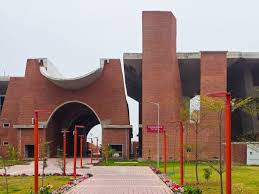
Prime Minister Narendra Modi will inaugurate the new Nalanda University campus near Rajgir’s ancient university ruins.
- Nalanda stands out as the most ancient university on the Indian Subcontinent.
- It was founded by Kumargupta of the Gupta dynasty in Bihar in the early 5th century, and it flourished for 600 years until the 12th century.
- During the era of Harshavardhan and the Pala monarchs, it rose to popularity.
- It was a center of learning, culture, and intellectual exchange that had a profound impact on the development of Indian civilization and beyond.
- Nalanda was a monastic establishment in the sense that it was primarily a place where monks and nuns lived and studied.
- It used to teach all the major philosophies of Buddhism.
- It had students from far-flung regions such as China, Korea, Japan, Tibet, Mongolia, Sri Lanka, and Southeast Asia.
- The students at Nalanda were expected to follow a strict code of conduct and were required to participate in daily meditation and study sessions.
- Subjects such as medicine, the ancient Indian medical system Ayurveda, religion, Buddhism, mathematics, grammar, astronomy, and Indian philosophy were taught there.
- It continued to be a centre of intellectual activity up until it was destroyed in the 12th century AD, in 1193, by Turkish ruler Qutbuddin Aibak’s general Bakhtiyar Khilji.
- After six centuries, the university was rediscovered in 1812 by Scottish surveyor Francis Buchanan-Hamilton and later identified as the ancient university by Sir Alexander Cunningham in 1861.
- The Chinese monk Xuan Zang has offered invaluable insights into the academic and architectural grandeur of ancient Nalanda.
- It is also a UNESCO World Heritage Site.
Direct Seeding Of Rice: Promotion

The Government of Punjab is actively promoting the Direct Seeding of Rice (DSR) also called the ‘tar-wattar’ technique of rice cultivation, which promises a multitude of advantages over traditional transplanting.
- However, the adoption of DSR in Punjab has been slow, with only 1.73 lakh acres (out of 79 lakh acres under paddy cultivation) using this technique in 2023.
- Direct Seeding of Rice (DSR) is the technique, farmers prepare nurseries where seeds are first sown.
- After 25-35 days, the young seedlings are uprooted and replanted, in the main field.
- This method is labour and water-intensive, it is known to maximise yields and maintain better crop health. It requires around 25-27 irrigations in total.
- Direct Seeding of Rice (DRS) is no nursery preparation or transplantation involved in this method.
- In DSR, the pre-germinated seeds are directly drilled into the field roughly 20-30 days prior to when they would have been transplanted by a tractor-powered machine.
- The field is irrigated and levelled prior to the seeding process which is carried out using a seed drill or lucky seeder.
- Before sowing seeds are treated by soaking in a fungicide solution.
- The first irrigation is carried out 21 days after sowing.
Double Sun halo : Celestial Phenomenon
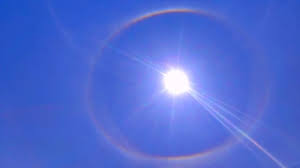
A rare celestial phenomenon known as a “double sun halo” was witnessed in the skies over Ladakh.
- It is a rare optical phenomenon where two concentric rings appear around the sun.
- This occurs when sunlight is refracted through ice crystals suspended in cirrus clouds, creating this dazzling visual effect.
- It is a variation of the more common 22-degree halo, where a bright ring encircles the sun.
- In this case, two halos are visible – an inner halo with a radius of approximately 22 degrees and an outer halo with a radius of around 46 degrees from the sun’s center.
- The formation of a double sun halo is a result of the unique shape and orientation of the ice crystals in the cirrus clouds.
- These crystals, typically hexagonal in shape, act as natural prisms, refracting and reflecting the sunlight in specific angles.
- When the ice crystals are randomly oriented, the refracted sunlight creates the inner 22-degree halo.
- However, if the crystals are aligned horizontally, with their flat faces parallel to the ground, an additional refraction occurs, resulting in the outer 46-degree halo.
- This precise alignment of the ice crystals is rare, making the double sun halo a relatively uncommon sight, especially in regions like Ladakh, where the atmospheric conditions are ideal for such phenomena.
Bitumen:
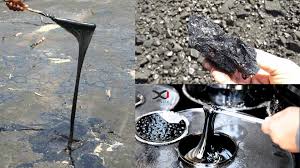
India is looking to start large-scale production of bio-bitumen from biomass or agricultural waste, a move that would help reduce imports of the material used for asphalting of roads.
- Bitumen is a dense, highly viscous, petroleum-based hydrocarbon.
- It is found in deposits such as oil sands and pitch lakes (natural bitumen) or is obtained as a residue of the distillation of crude oil.
- It owes its density and viscosity to its chemical composition—mainly large hydrocarbon molecules known as asphaltenes and resins, which are present in lighter oils but are highly concentrated in bitumen.
- In addition, bitumen frequently has a high content of metals, such as nickel and vanadium, and nonmetallic inorganic elements, such as nitrogen, oxygen, and sulfur.
- It is known for its waterproofing and adhesive properties and is commonly used in the construction industry, notably for roads and highways.
- It is commonly used to waterproof boats and other marine vessels.
- It is also used by companies that create and manufacture roofing products.
- It is used for sealing and insulating purposes in various building materials such as carpet tile backing and paint.
Bio-bitumen:
- It is a petroleum-free alternative to bitumen, or asphalt.
- It’s made using non-petroleum-based renewable resources and can be made from vegetable oils, synthetic polymers, or both, making it a more sustainable model long term.
Sahitya Akademi Yuva Puraskar:
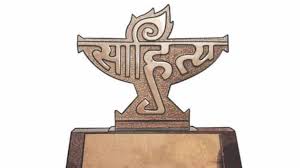
A 26-year-old writer from the tribal thanda of Vivek Nagar in Jakranpally mandal of Nizamabad district, Ramesh Karthik Naik, was awarded the Sahitya Akademi Yuva Puraskar for Telugu.
- Sahitya Akademi Yuva Puraskar was first instituted in 2011.
- It is presented annually to best literary creations by the young writers of age 35 or below in all the 24 recognized languages.
- The Yuva Puraskar is conferred on eligible young writers for creative original works.
- It is the only Akademi award open for nominations by publishers and self-nominations by writers.
- The Yuva Puraskar comprises a plaque, shawl, citation and a cheque for Rupees Fifty Thousand (₹ 50,000).
- A posthumous publication is not eligible for Award.
Krishi Sakhi Convergence Programme:
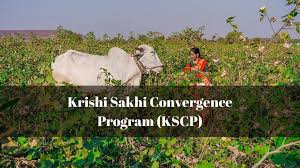
The Prime Minister of India granted certificates to over 30,000 women from Self Help Groups (SHGs) as ‘Krishi Sakhis’ under the Krishi Sakhi Convergence Programme (KSCP).
- Krishi Sakhi Convergence Program aims to transform rural India through the empowerment of rural women as Krishi Sakhi, by imparting training and certification of Krishi Sakhis as Para-extension Workers.
- This certification course also aligns with the objectives of the ‘Lakhpati Didi’ Program.
- Krishi Sakhis have already been trained on various extension service
- Agro-Ecological Practices: From land preparation to harvest.
- Organizing Farmer Field Schools: Facilitating practical learning sessions for farmers.
- Seed Banks: Establishment and management.
- Soil Health and Conservation: Techniques for maintaining soil health and moisture.
- Integrated Farming Systems: Combining various farming practices for sustainability.
- Livestock Management: Basic management practices for livestock.
- Bio Inputs: Preparation, use, and establishment of bio-input shops.
- Communication Skills: Essential skills for effective communication with farmers.
- These Krishi Sakhis are undergoing refresher training with a special focus on Natural Farming and Soil Health Card through DAY-NRLM agencies in coordination with MANAGE.
- Krishi Sakhi Training Program has been rolled out in 12 states in Phase – 1: Gujarat, Tamil Nadu, Uttar Pradesh, Madhya Pradesh, Chhattisgarh, Karnataka, Maharashtra, Rajasthan, Odisha, Jharkhand, Andhra Pradesh, and Meghalaya.




